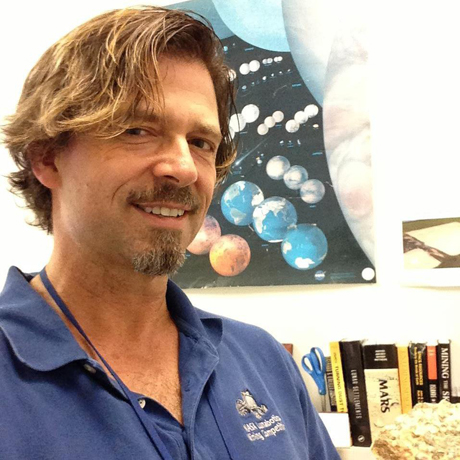Dr. Philip T. Metzger
Philip T. Metzger, Ph.D. works at NASA’s Kennedy Space Center as the lead research physicist and founder of the Granular Mechanics and Regolith Operations (GMRO) Lab, part of the Surface Systems Swamp Works.
Phil has worked in the space program since 1985. He was a part of the Space Shuttle launch team and later with the International Space Station Program testing and assembling spaceflight hardware. For the past 10 years, he has performed research and technology development for solar system exploration (Moon, Mars, asteroids, etc.).
His interests include the utilization of space resources and finding ways to address the dwindling of non-renewable resources on Earth and its effects upon civilization. This includes in-space manufacturing and self-sustaining/self-reproducing space robotics to open up the full resources of the solar system.
In the past several years Phil has been principal investigator or lead researcher for several million dollars’ worth of projects focused on the utilization of space resources (prospecting, excavation, conveyance, beneficiation, processing, and in-space manufacturing), space robotics, methods of launching and landing on planetary surfaces, and the physics of soil on the Moon, Mars and asteroids (rocket exhaust plume interactions with planetary surfaces, geological/geotechnical properties, and magnetics), encompassing experimental, theoretical, and simulation projects. He led the plume/ejecta studies for the Lunar Architecture Team, Mars Architecture Team, and Constellation Architecture Team.
His papers include Rocket Exhaust Cratering: A Significant Challenge for Space Exploration, Integrating Beneficiation into Regolith Conveyance Systems, Granular contact force density of states and entropy in a modified Edwards ensemble, Elegance of disordered granular packings: a validation of Edwards’ hypothesis, Photogrammetry and ballistic analysis of a high-flying projectile in the STS-124 space shuttle launch, Electric Potential Due to a System of Conducting Spheres, Spatial and Temporal Extrapolation of Disdrometer Size Distributions Based on a Lagrangian Trajectory Model of Falling Rain, H theorem for contact forces in granular materials, and Craters Formed in Granular Beds by Impinging Jets of Gas.
He earned a B.S.E. (electrical engineering) from Auburn University in 1985, a M.S. in physics from the University of Central Florida in 2000, and a Ph.D. in physics from the University of Central Florida in 2005. His doctoral work focused on the theoretical statistical mechanics of granular materials with applications to the mechanics of lunar and planetary soils.
Phil is a member of the American Society of Civil Engineers (ASCE) Granular Materials Committee, the ASCE Technical Committee for Regolith Operations, Mobility, and Robotics (ROMR), and the National Space Society. He has been co-convener for the series of NASA/ASCE Workshops on Granular Materials in Lunar/Martian Exploration, and convener for the series of Workshops on Plume Effects in Lunar and Martian Exploration. He is also involved in numerous educational outreaches, including serving as a judge for NASA’s annual Lunabotics Lunar Excavation Challenge, a robotics competition for college students, and serving as an Assistant Cubmaster for a Cub Scout pack.
Read his LinkedIn profile.
